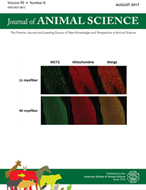-
Views
-
Cite
Cite
P. B. Wall, G. H. Rouse, D. E. Wilson, R. G. Tait, W. D. Busby, Use of ultrasound to predict body composition changes in steers at 100 and 65 days before slaughter, Journal of Animal Science, Volume 82, Issue 6, June 2004, Pages 1621–1629, https://doi.org/10.2527/2004.8261621x
Close - Share Icon Share
ABSTRACT
Steers from research crossbreeding projects (n = 406) were serially scanned using real-time ultrasound at 35-d intervals from reimplant time until slaughter. Cattle were evaluated for rump fat depth, longissimus muscle area (ULMA), 12th-rib fat thickness (UFAT), and percentage of intramuscular fat (IMF) to determine the ability of ultrasound to predict carcass composition at extended periods before slaughter. Additional background information on the cattle, such as live weight, ADG, breed of sire, breed of dam, implant, and frame score was also used. Carcass data were collected by trained personnel at “chain speed,” and samples of the 12th-rib LM were taken for ether extract analysis. Simple correlation coefficients showed positive relationships (P < 0.01) between ultrasound measures taken less than 7 d before slaughter and carcass measures: ULMA and carcass LM area (CLMA, r = 0.66); UFAT and carcass 12th-rib fat thickness (CFAT, r = 0.74); and IMF and carcass numeric marbling score (r = 0.61). The same correlation coefficients for ultrasound measures taken 96 to 105 d before slaughter and carcass values (P < 0.01) were 0.52, 0.58, and 0.63, respectively. Steers were divided into source-verified and nonsource-verified groups based on the level of background information for each individual. Regression equations were developed for the carcass measurements; 46% of the variation could be explained for CLMA and 44% of CFAT at reimplant time, 46% of the variation in quality grade and 42% of the variation in yield grade could be explained. Significant predictors of quality grade were IMF (P < 0.001), natural log of 12th-rib fat thickness (LUFAT, P < 0.001), and ADG (P < 0.01), whereas LUFAT (P < 0.001), ULMA (P < 0.01), live weight (P < 0.001), hip height (P < 0.001), and frame score (P < 0.001) were significant predictors of yield grade. Regressions using ultrasound data taken 61 to 69 d before slaughter showed increasing R2. Live ultrasound measures at reimplant time are a viable tool for making decisions regarding future carcass composition.





